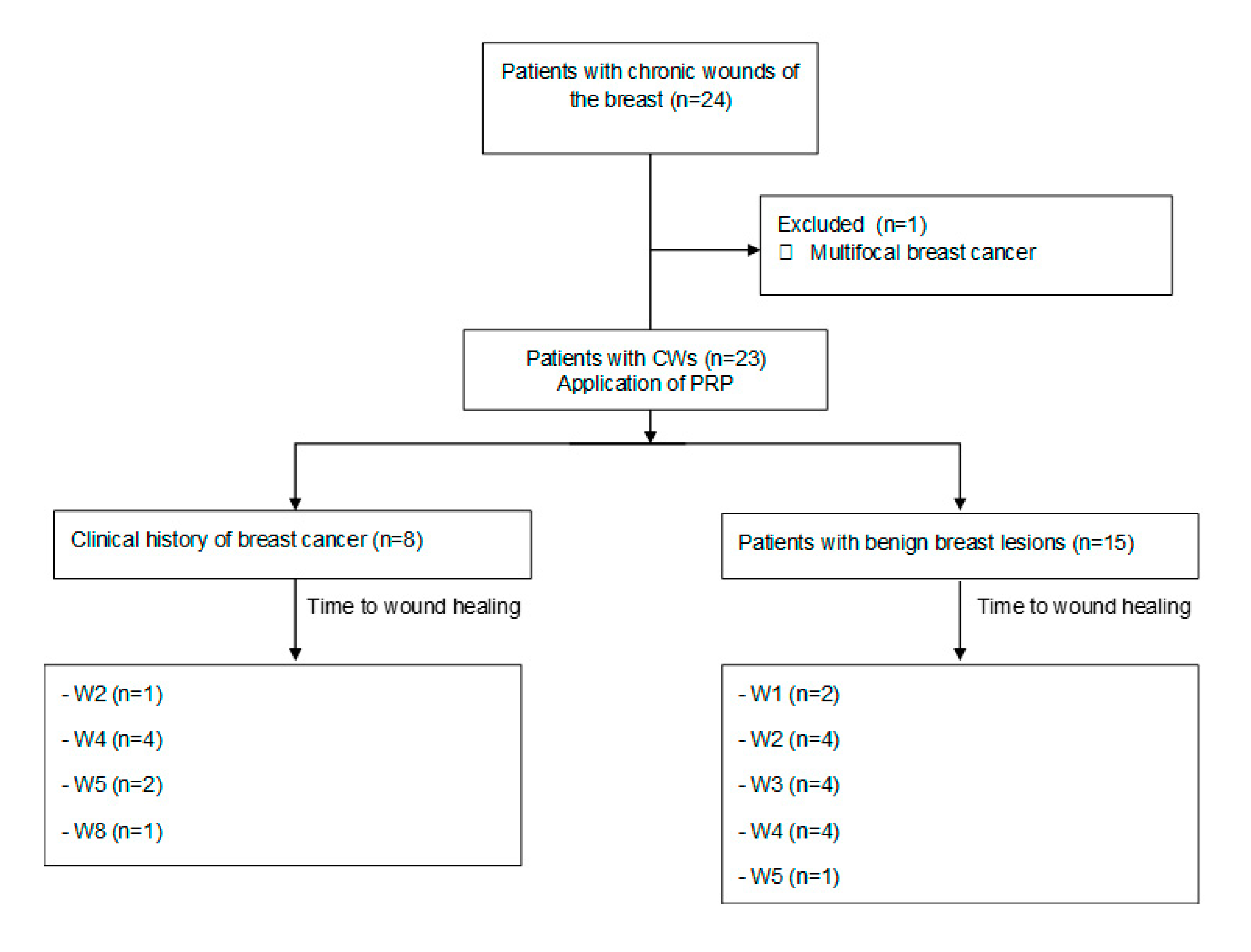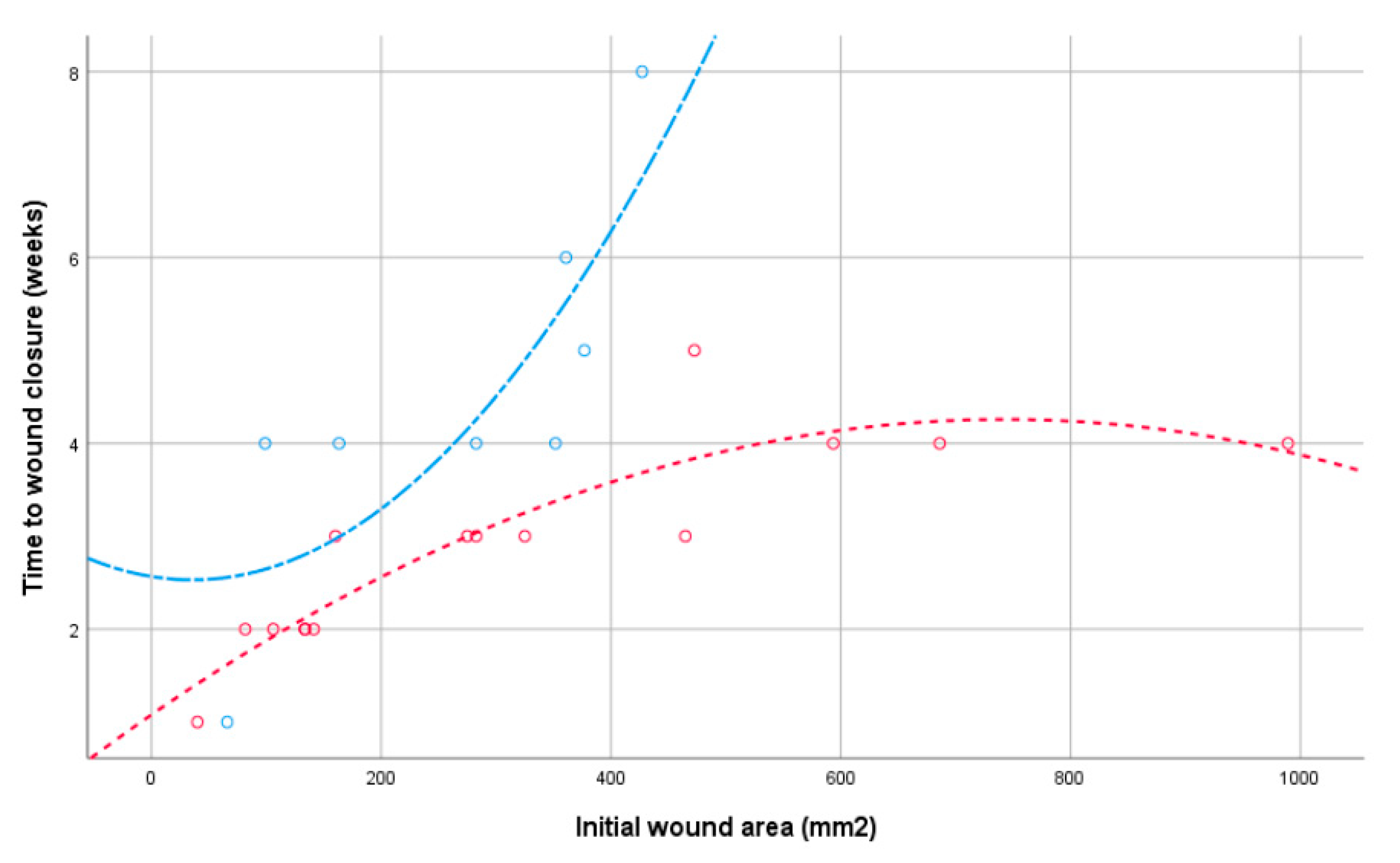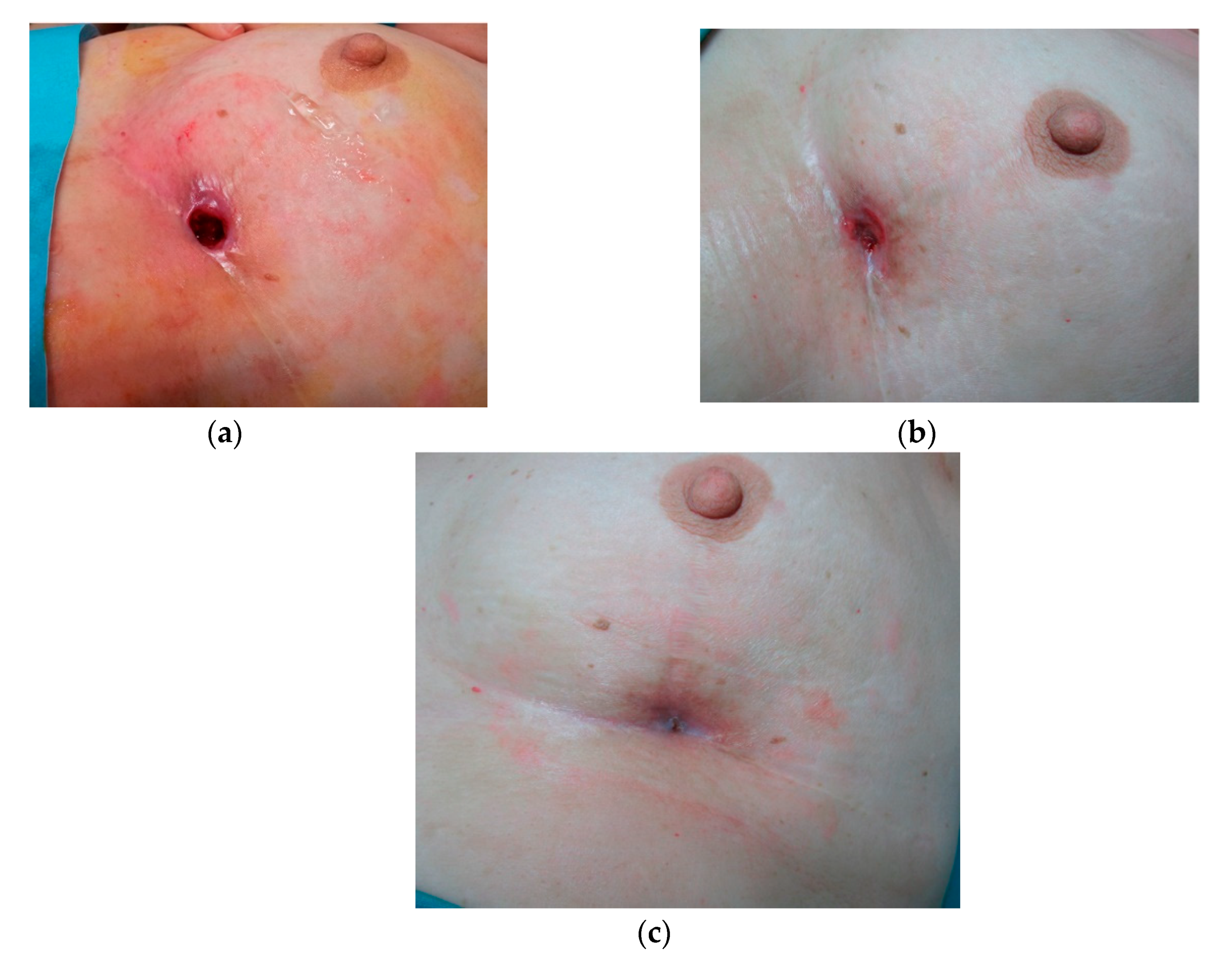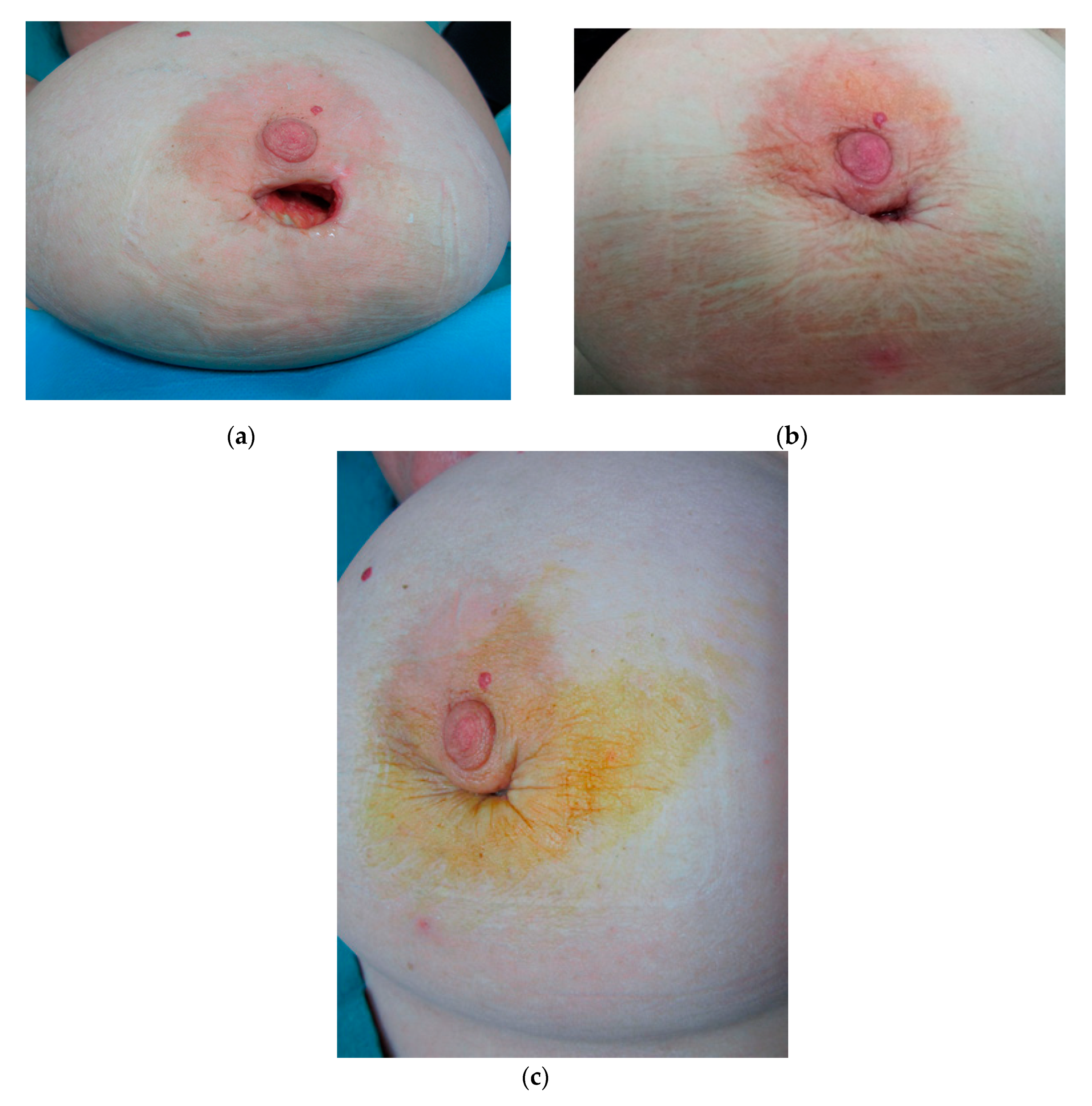A New Therapeutic Application of Platelet-Rich Plasma to Chronic Breast Wounds: A Prospective Observational Study
Abstract
1. Introduction
2. Patients and Methods
2.1. Patients
2.2. PRP Preparation
2.3. Treatment Protocol
2.4. Data Collection
2.5. Statistical Analysis
3. Results
3.1. Participants and Wound Healing
3.2. Characteristics Influencing the Time to Wound Healing
4. Discussion
5. Conclusions
Author Contributions
Funding
Acknowledgments
Conflicts of Interest
References
- Frykberg, R.G.; Banks, J. Challenges in the treatment of chronic wounds. Adv. Wound Care (New Rochelle) 2015, 4, 560–582. [Google Scholar] [CrossRef] [PubMed]
- Piccin, A.; Di Pierro, A.M.; Canzian, L.; Primerano, M.; Corvetta, D.; Negri, G.; Mazzoleni, G.; Gastl, G.; Steurer, M.; Gentilini, I.; et al. Platelet gel: A new therapeutic tool with great potential. Blood Transfus. 2017, 15, 333–340. [Google Scholar] [PubMed]
- Prabhu, R.; Vijayakumar, C.; Chandra, A.; Balagurunathan, K.; Kalaiarasi, R.; Venkatesan, K.; Raja, E.S.; Swetha, T. Efficacy of homologous, platelet-rich plasma dressing in chronic non-healing ulcers: An observational study. Cureus 2018, 10, e2145. [Google Scholar] [CrossRef]
- Gottrup, F. Optimizing wound treatment through health care structuring and professional education. Wound Repair Regen. 2004, 12, 129–133. [Google Scholar] [CrossRef] [PubMed]
- Lazarus, G.S.; Cooper, D.M.; Knighton, D.R.; Percoraro, R.E.; Rodeheaver, G.; Robson, M.C. Definitions and guidelines for assessment of wounds and evaluation of healing. Wound Repair Regen. 1994, 2, 165–170. [Google Scholar] [CrossRef]
- Carter, M.J.; Fylling, C.P.; Parnell, L.K. Use of platelet rich plasma gel on wound healing: A systematic review and meta-analysis. Eplasty 2011, 11, e38. [Google Scholar]
- Andia, I.; Abate, M. Platelet-rich plasma: Underlying biology and clinical correlates. Regen. Med. 2013, 8, 645–658. [Google Scholar] [CrossRef]
- Suthar, M.; Gupta, S.; Bukhari, S.; Ponemone, V. Treatment of chronic non-healing ulcers using autologous platelet rich plasma: A case series. J. Biomed. Sci. 2017, 24, 16. [Google Scholar] [CrossRef]
- Rainys, D.; Cepas, A.; Dambrauskaite, K.; Nedzelskiene, I.; Rimdeika, R. Effectiveness of autologous platelet-rich plasma gel in the treatment of hard-to-heal leg ulcers: A randomised control trial. J. Wound Care 2019, 28, 658–667. [Google Scholar] [CrossRef]
- Eppley, B.L.; Pietrzak, W.S.; Blanton, M. Platelet-rich plasma: A review of biology and applications in plastic surgery. Plast. Reconstr. Surg. 2006, 118, 147e–159e. [Google Scholar] [CrossRef]
- Alsousou, J.; Ali, A.; Willett, K.; Harrison, P. The role of platelet-rich plasma in tissue regeneration. Platelets 2013, 24, 173–182. [Google Scholar] [CrossRef] [PubMed]
- Etulain, J. Platelets in wound healing and regenerative medicine. Platelets 2018, 29, 556–568. [Google Scholar] [CrossRef] [PubMed]
- Samadi, P.; Sheykhhasan, M.; Khoshinani, H.M. The use of platelet-rich plasma in aesthetic and regenerative medicine: A comprehensive review. Aesth. Plast. Surg. 2019, 43, 803–814. [Google Scholar] [CrossRef] [PubMed]
- Fan, Y.; Perez, K.; Dym, H. Clinical uses of platelet-rich fibrin in oral and maxillofacial surgery. Dent. Clin. N. Am. 2010, 64, 291–303. [Google Scholar] [CrossRef] [PubMed]
- Sánchez, M.; Delgado, D.; Sánchez, P.; Fiz, N.; Azofra, J.; Orive, G.; Anitua, E.; Padilla, S. Platelet rich plasma and knee surgery. Biomed. Res. Int. 2014, 2014, 890630. [Google Scholar] [CrossRef]
- Salamanna, F.; Veronesi, F.; Maglio, M.; Della Bella, E.; Sartori, M.; Fini, M. New and emerging strategies in platelet-rich plasma application in musculoskeletal regenerative procedures: General overview on still open questions and outlook. Biomed. Res. Int. 2015, 2015, 846045. [Google Scholar] [CrossRef]
- Dawood, A.S.; Salem, H.A. Current clinical applications of platelet-rich plasma in various gynecological disorders: An appraisal of theory and practice. Clin. Exp. Reprod. Med. 2018, 45, 67–74. [Google Scholar] [CrossRef]
- Anitua, E.; Aguirre, J.J.; Algorta, J.; Ayerdi, E.; Cabezas, A.I.; Orive, G.; Andia, I. Effectiveness of autologous preparation rich in growth factors for the treatment of chronic cutaneous ulcers. J. Biomed. Mater. Res. B Appl. Biomater. 2008, 84, 415–421. [Google Scholar] [CrossRef]
- Xia, Y.; Zhao, J.; Xie, J.; Lv, Y.; Cao, D.S. The efficacy of platelet-rich plasma dressing for chronic nonhealing ulcers: A meta-analysis of 15 randomized controlled trials. Plast. Reconstr. Surg. 2019, 144, 1463–1474. [Google Scholar] [CrossRef]
- Smith, O.J.; Jell, G.; Mosahebi, A. The use of fat grafting and platelet-rich plasma for wound healing: A review of the current evidence. Int. Wound J. 2019, 16, 275–285. [Google Scholar] [CrossRef]
- Liao, X.; Liang, J.X.; Li, S.H.; Huang, S.; Yan, J.X.; Xiao, L.L.; Song, J.-X.; Liu, H.-W. Allogeneic platelet-rich plasma therapy as an effective and safe adjuvant method for chronic. Wounds J. Surg. Res. 2020, 246, 284–291. [Google Scholar] [CrossRef] [PubMed]
- Gould, L.; Li, W.W. Defining complete wound closure: Closing the gap in clinical trials and practice. Wound Repair. Regen. 2019, 27, 201–224. [Google Scholar] [CrossRef] [PubMed]
- Kundin, J.L. Designing and developing a new measuring instrument. Perioper. Nurs. Q. 1985, 1, 40–45. [Google Scholar]
- Zelen, C.M.; Orgill, D.P.; Serena, T.; Galiano, R.; Carter, M.J.; DiDomenico, L.A.; Keller, J.; Kaufman, J.; Li, W.W. A prospective, randomised, controlled, multicentre clinical trial examining healing rates, safety and cost to closure of an acellular reticular allogenic human dermis versus standard of care in the treatment of chronic diabetic foot ulcers. Int. Wound J. 2017, 14, 307–315. [Google Scholar] [CrossRef] [PubMed]
- Martinez-Zapata, M.J.; Marti-Carvajal, A.J.; Sola, I.; Expósito, J.A.; Bolíbar, I.; Rodríguez, L.; Garcia, J.; Zaror, C. Autologous platelet-rich plasma for treating chronic wounds. Cochrane Database Syst. Rev. 2016, 5, CD006899. [Google Scholar] [CrossRef]
- Hebert-Croteau, N.; Freeman, C.R.; Latreille, J.; Rivard, M.; Brisson, J. A population-based study of the impact of delaying radiotherapy after conservative surgery for breast cancer. Breast Cancer Res. Treat. 2004, 88, 187–196. [Google Scholar] [CrossRef]
- Hillberg, N.S.; Meesters-Caberg, M.A.J.; Beugels, J.; Winkens, B.; Vissers, Y.L.J.; van Mulken, T.J.M. Delay of adjuvant radiotherapy due to postoperative complications after oncoplastic breast conserving surgery. Breast 2018, 39, 110–116. [Google Scholar] [CrossRef]
- Tsoutsou, P.G.; Koukourakis, M.I.; Azria, D.; Belkacémi, Y. Optimal timing for adjuvant radiation therapy in breast cancer: A comprehensive review and perspectives. Crit. Rev. Oncol. Hematol. 2009, 71, 102–116. [Google Scholar] [CrossRef]
- Kapadia, S.M.; Reitz, A.; Hart, A.; Broecker, J.; Torres, M.A.; Carlson, G.W.; Styblo, T.M.; Losken, A. Time to radiation after oncoplastic reduction. Ann. Plast. Surg. 2019, 82, 15–18. [Google Scholar] [CrossRef]
- Omar, N.N.; El-Tawdi, A.H.; Tash, R.F.; Shoukry, Y.; Mahmoud, N.A.; El Bakly, W. Tumor potential in rat wounds after short- and long-term administration of platelet-rich plasma. J. Biol. Regul. Homeost. Agents 2017, 31, 889–899. [Google Scholar]






| Demographics and Background | All Samples (n = 23) | With Cancer (n = 8) | Without Cancer (n = 15) | p-Value |
|---|---|---|---|---|
| Age (years), mean ± SD | 49.6 ± 16.0 | 62.2 ± 15.6 | 42.8 ± 11.8 | 0.003 |
| BMI *, mean ± SD | 27.2 ± 2.7 | 27.8 ± 2.9 | 26.9 ± 2.6 | 0.497 |
| Smoker | 11 (47.8) | 0 (0) | 11 (73.3) | 0.001 |
| Without Diabetes | 21 (91.3) | 7 (87.5) | 14 (93.3) | 0.999 |
| Clinical characteristics | ||||
| Duration of previous treatments (weeks), mean ± SD | 10.8 ± 2.6 | 12.0 ± 2.7 | 10.1 ± 2.4 | 0.106 |
| Abscess with drainage | 4 (17.4) | 1 (12.5) | 3 (20) | 1.0 |
| Seromas with drainage | 4 (17.4) | 4 (50.0) | 0 (0) | 0.008 |
| With dehiscence | 3 (13.0) | 2 (25.0) | 1 (6.7) | 0.269 |
| With fat necrosis | 3 (13.0) | 1 (12.5) | 2 (13.3) | 0.999 |
| Initial wound area (mm2), Mean ± SD | 304.8 ± 230.0 | 265.9 ± 138.0 | 325.6 ± 268.8 | 0.565 |
| Right breast | 14 (60.9) | 5 (62.5) | 9 (60.0) | 1.0 |
| Wound location | 0.123 | |||
| Upper outer quadrant | 6 (26.1) | 2 (25.0) | 4 (26.7) | |
| Periareolar | 15 (65.2) | 4(50.0) | 11 (73.3) | |
| Lower outer quadrant | 2 (8.7) | 2 (25.0) | 0 (0) | |
| Variables | Univariate Models HRs * (95% CI) p-Value | Multivariate Model |
|---|---|---|
| Body mass index | 0.93 (0.82–1.06) 0.305 | |
| Smoker | 2.21 (0.87–5.58) 0.101 | |
| Nondiabetic | 1.67 (0.38–7.05) 0.516 | |
| Weeks in previous treatment | 0.84 (0.69–1.01) 0.067 | |
| With cancer (vs. without) | 2.72 (1.02–7.29) 0.046 | 7.08 (2.01–24.92) 0.002 |
| Had abscess drainage | 1.28 (0.43–3.87) 0.659 | |
| Had fat necrosis | 1.10 (0.32–3.86) 0.883 | |
| Right breast | 2.33 (0.84–6.47) 0.110 | |
| Location | ||
| Upper outer quadrant | Reference | |
| Periareolar | 0.97 (0.37–2.53) 0.969 | |
| Lower outer quadrant | N.A. ** 0.957 | |
| Initial area (mm2) | 0.99 (0.99–1.00) 0.050 | 0.99 (0.992–0.998) 0.004 |
© 2020 by the authors. Licensee MDPI, Basel, Switzerland. This article is an open access article distributed under the terms and conditions of the Creative Commons Attribution (CC BY) license (http://creativecommons.org/licenses/by/4.0/).
Share and Cite
Berná-Serna, J.d.D.; Guzmán-Aroca, F.; García-Vidal, J.A.; Hernández-Gómez, D.; García-Ortega, A.A.; Chivato Martín-Falquina, T.; Piñero-Madrona, A.; Berná-Mestre, J.d.D. A New Therapeutic Application of Platelet-Rich Plasma to Chronic Breast Wounds: A Prospective Observational Study. J. Clin. Med. 2020, 9, 3063. https://doi.org/10.3390/jcm9103063
Berná-Serna JdD, Guzmán-Aroca F, García-Vidal JA, Hernández-Gómez D, García-Ortega AA, Chivato Martín-Falquina T, Piñero-Madrona A, Berná-Mestre JdD. A New Therapeutic Application of Platelet-Rich Plasma to Chronic Breast Wounds: A Prospective Observational Study. Journal of Clinical Medicine. 2020; 9(10):3063. https://doi.org/10.3390/jcm9103063
Chicago/Turabian StyleBerná-Serna, Juan de Dios, Florentina Guzmán-Aroca, José A. García-Vidal, Dolores Hernández-Gómez, Ana Azahara García-Ortega, Tomás Chivato Martín-Falquina, Antonio Piñero-Madrona, and Juan de Dios Berná-Mestre. 2020. "A New Therapeutic Application of Platelet-Rich Plasma to Chronic Breast Wounds: A Prospective Observational Study" Journal of Clinical Medicine 9, no. 10: 3063. https://doi.org/10.3390/jcm9103063
APA StyleBerná-Serna, J. d. D., Guzmán-Aroca, F., García-Vidal, J. A., Hernández-Gómez, D., García-Ortega, A. A., Chivato Martín-Falquina, T., Piñero-Madrona, A., & Berná-Mestre, J. d. D. (2020). A New Therapeutic Application of Platelet-Rich Plasma to Chronic Breast Wounds: A Prospective Observational Study. Journal of Clinical Medicine, 9(10), 3063. https://doi.org/10.3390/jcm9103063





